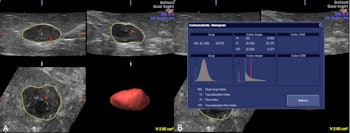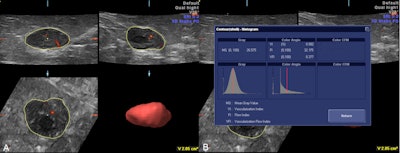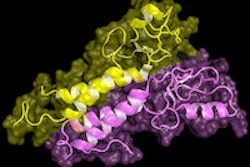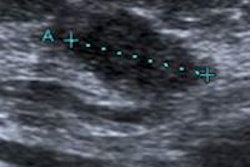
Using vascular indexes obtained via 3D power Doppler ultrasound can accurately characterize suspicious breast masses, and adding it to 2D ultrasound may reduce unnecessary biopsies, noted Turkish researchers in an article published online on 31 October in the European Journal of Radiology.
The prospective study evaluated radiologically or clinically suspicious breast masses using 3D power Doppler ultrasound before biopsy. Final diagnoses were obtained with histopathologic analysis of core and/or excisionally biopsied masses. Vascular indexes were calculated and correlated with the final diagnosis to determine whether they adequately characterize breast masses. A team led by radiologist Dr. Ali Kupeli from Karadeniz Technical University Faculty of Medicine at Farabi Hospital in Trabzon, Turkey, found they do.


A 36-year-old woman with fibroadenoma. Decreased vascularization was seen in 3D power Doppler ultrasound (A) and also decreased vascular indexes in the histogram (B). Image courtesy of Dr. Ali Kupeli.
The vascular indexes obtained with 3D power Doppler ultrasound seem a reliable technique in the further characterization of suspicious breast masses, the authors wrote. Adding 3D power Doppler ultrasound to 2D ultrasound may cut unnecessary biopsies.
What is 3D power Doppler ultrasound?
Mammography and ultrasound are the most widely used radiological methods for the diagnosis of breast cancer, but their specificities are low. Because of this, approximately 40% to 60% of the breast biopsies performed based on mammographic and ultrasonographic findings result in benign diagnosis, according to the study authors.
One of the techniques used to increase the specificity and positive predictive value (PPV) in breast imaging is 3D power Doppler ultrasound, which can evaluate vascularity of breast tumors. Power Doppler ultrasound is superior to color Doppler ultrasound in the differentiation of benign from malignant breast tumors, the authors wrote. This is primarily because it has higher sensitivity to low flow rates, independent from the Doppler angle and no aliasing artifacts.
Three vascular indexes were obtained in this study using a Voluson 730 Expert, GE Healthcare system: vascularization index, flow index, and vascularization flow index. Vascularization index is the ratio of color voxels to all voxels in the interested volume and shows the density of vessels. Flow index is the mean value of all color voxels in the studied volume and represents average color intensity. Vascularization flow index is the combination of the two and the sum of weighted color voxels divided by all voxels, and it shows vascularization and perfusion.
Some studies showed malignant masses had significantly higher vascular indexes than benign ones, but there are conflicting results about which vascularity parameter is more effective, and it is unknown how much unnecessary biopsies could be prevented, something the authors sought to find out.
Summary of key results
The researchers enrolled 109 patients with 117 radiologically or clinically suspicious breast masses. All vascular indexes and tumor volume were significantly lower in benign masses compared with malignant ones (p < 0.001). There were 63 (53.8%) malignant masses in total.
| Diagnostic efficacy | ||||
| Cutoff | Sensitivity | Specificity | Accuracy | |
| Vascularization index | 1.1 | 83% | 82% | 82% |
| Vascularization flow index | 0.4 | 80% | 83% | 80% |
| Flow index | 33.9 | 73% | 69% | 71% |
To determine how much unnecessary biopsies could be reduced without missing malignant tumors with 3D power Doppler ultrasound vascular indexes, new cutoff values that provided 100% sensitivity and negative predictive value (NPV) also were determined. Those cuttoffs were found as 0.10 for vascularization index, 24.20 for flow index, and 0.02 for vascularization flow index. With the use of those new cutoffs, 20 biopsies (37%) for vascularization index, 13 biopsies (24%) for flow index, and 16 biopsies (30%) for vascularization flow index could have been avoided from the 54 benign tumors.
This is an improvement on the number of high biopsies found in mammography and 2D ultrasound, the authors wrote.
"We need new noninvasive diagnostic methods to be able to decrease this high unnecessary biopsy rate," they added. "In the present study, with the use of 3D power Doppler ultrasound in the further characterization of suspicious breast masses, it was possible to obtain a 24% to 37% decrease in negative biopsies without missing any malignancy. We did not make a cost-benefit analysis and these numbers might not be enough for clinical acceptability of this management strategy."
Limitations
The study has a number of limitations. Ultrasound is highly operator- and patient-dependent, and during 3D examination, motion of the patient or operator's hand affects the quality of the Doppler signals. Therefore, repeat exams might be needed, especially in patients unable to hold their breath long enough.
The authors added that there were not enough patients to investigate the effectiveness of 3D power Doppler ultrasound on subtypes of benign and malignant breast masses. Also, peritumoral vascularity, which is reported as an additional effective parameter that can be measured with 3D power Doppler ultrasound, was not evaluated.
Another limitation is the significant difference in the mean volumes of the benign and malignant masses of the study. In addition, this technique can be inappropriate for tumors whose size is larger than the coverage of the 3D ultrasound probe, and all ultrasound machines do not contain the necessary software, the authors noted
Still, vascular indexes obtained with 3D power Doppler ultrasound seem reliable in characterizing suspicious breast masses. However, extensive studies with larger populations are needed to clearly document the effectiveness of the method, the researchers concluded.



















